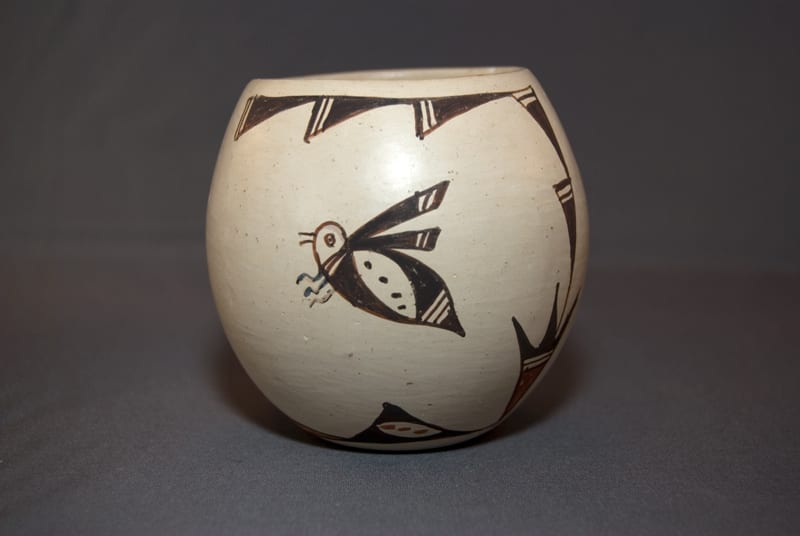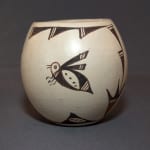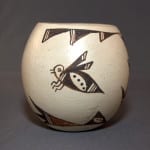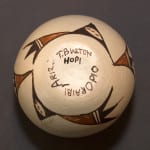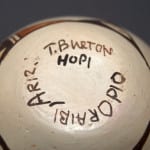Little pottery is made in Orabi (or at Third Mesa), and most of that is utility ware. This is one of two painted pots from Third Mesa in the collection. The other (2011-11) is also by Treva Burton.
Treva Burton was born on April 8, 1929 and is the younger sister of Bessie Monongye (pot 2002-05). Like her sister, she was taught pottery and basket making by her grandmother. She continues to make both crafts, often with her sister. For photographs and more detailed information, see Teiwes (1996: 25,39,41,137-139).
Although some pottery made at Third Mesa is still traditionally outdoor fired with dung, this pot was kiln-fired: it has a bleached-white look and a high-pitched ring when struck on the edge. One potter in Orabi, owns an electric kiln and uses a 0.05 firing cone (1046 to 1062 degrees C). She fires her own pots and charges a small fee to fire the pottery of other makers. Although Lydia Wyckoff uses pseudonyms, it seems likely that either Treva Burton or her sister Bessie Monongye own the kiln (1985: 116, 149 and 158).
Wyckoff finds that the small amount of painted pottery produced on Third Mesa exhibits two very different painting styles, which she labels “A” and “B.” Pot 2010-06 is a clear example of “Style A.” A number of design differences distinguish the two styles.
“Style A prefers a separation between the design and the space surrounding it, so that
the design…stands out clearly from the background and is easily recognizable…A
discrete unit design is created when a motif….forms a(n) area of decoration
surrounded by space. The decorated area, when it is facing the viewer, can be seen in
its entirety….the other units of decoration are usually not visible. The overall effect,
therefore likens the body of the vessel to a sheet of paper containing a central
figure…This is the most profound difference between the decoration of Style A and
Style B (Wyckoff, 1985:93).”
The central insect image on pot 2010-06 is a clear example of this discrete design element and defines the decoration as “Style A.”
Style B pots are a Third Mesa varient of Sikyatki revival design and emphasize the overall pattern on a pot. Style B vessels frequently employ “figure-ground reversal” or “negative design” so that “when you look at the pot the figure and the background against which it is placed keep changing places, the figure becomes the background and the background becoming the figure (Wyckoff, 1985:100 and 94-103).” Nampeyo is particularly known for this use of negative space (cf. pot 2005-16). In sharp contrast Style A pots simply use decoration to frame the central isolated image, as on pot 2010-06.
Finally, Style B and Sikyatki Revival pots “commonly use the organizational technique of rotation….figures rotate around a series of point axes.” In contrast, Style A pots use an organizational technique known as translation, which consists of repeated figures translated along a band without change in directional orientation.” (Wyckoff, 1985:102-103, summary 111-112).
These differences in design technique are well represented by pot 2010-06 whose “Style A” decoration contrasts with all of the other decorated Hopi and Hopi/Tewa pots in this collection.
Wyckoff concludes that this difference in pottery style reflects a profound difference in worldview between potters and is an expression of the division between Traditionalists (Style A) and Progressive (Style B) Hopi, a division that has bedeviled Orabi since regular contact with Anglos (1985:145-147). Somewhat contradicting this conclusion is jar 2011-11 in this collection. That jar, also by Treva Burton, has a well-crafted Sitkatki Revival eagle-tail design (Style B). It would be interesting to know when pots 2010-06 and 2011-11 were made: perhaps Treva Burton changed her world-view over time. More likely Third Mesa potters (or at least this potter) who made “Style A” also produced “Style B” pots, at least that is what the two Burton pots in this collection indicated.
There were only five “Style A” Traditionalist potters working on Third Mesa when Wyckoff began her research in 1979. At least three of the five are represented in this collection: sisters Treva Burton and Bessie Monongye of Orabi and Vera Pooyoume of Hotevilla (1987-02 and 2005-01). The collection also contains a number of unsigned utility pots from Third Mesa that may have been made by other Traditionalist potters. (See “Category List.”) In 1979 there were three Traditional potters in Orabi. Nine years later, in 1988, sisters Treva and Bessie were the only Traditional potters still working in the village (1985:115, 149). I visited Orabi several times in the early 1990’s looking for pottery. I was directed to the homes of Treva Burton and Bessie Monongye, but either they were not at home or did not have pottery for sale.

